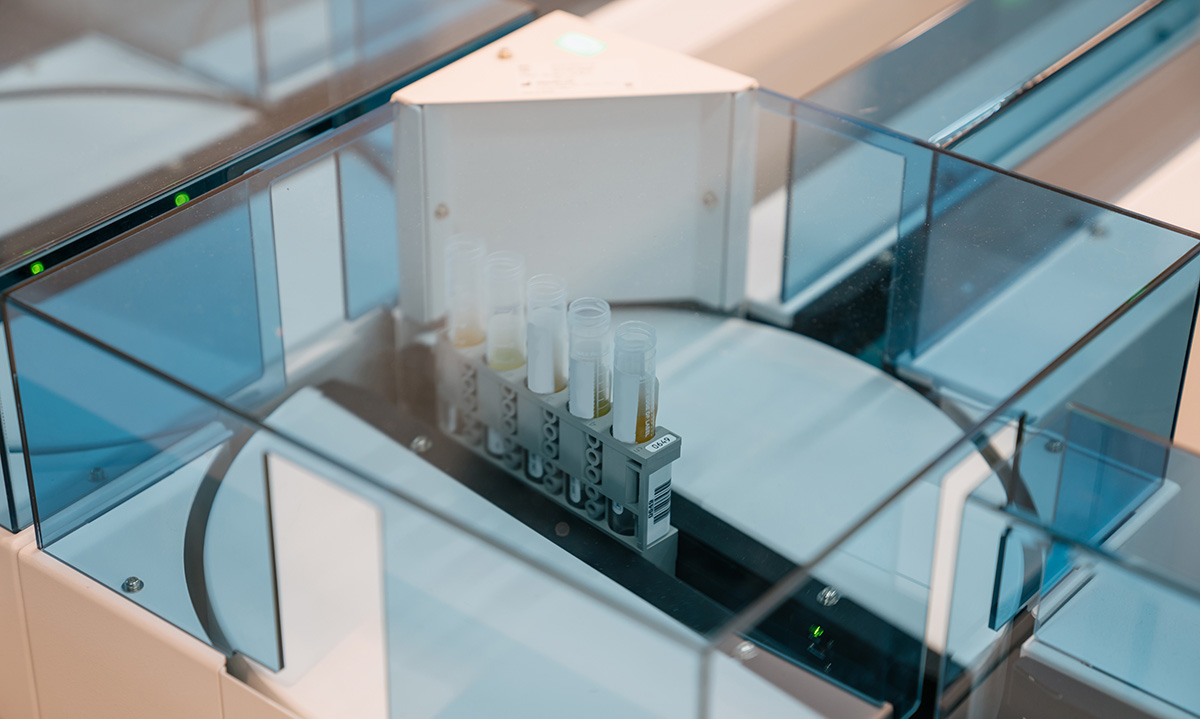
New automation installed in the Automated Core Lab increases ARUP’s testing capacity, provides better turnaround times, reduces risk of human error, and improves staff satisfaction.
During the last decade, sample volumes in ARUP’s Automated Core Laboratory have nearly doubled. Now, the lab processes more than 300,000 samples per month. To meet the increased demand, ARUP’s team has implemented an almost total automation system this year that will centrifuge samples, remove caps, deliver samples to the correct instruments, run ordered tests, perform on-board dilutions, and sort samples for storage, all without human intervention.
Jeremy Smith, MS, BSN, MLS(ASCP)CM, an ARUP medical laboratory scientist, Dhwani Patel, MS, MLS(ASCP), supervisor of the Automated Core Lab, and Janalee Renshaw, MT(ASCP), IT clinical systems architect, all played key roles in implementing this automation. They presented on their success at the Oracle Cerner Health Conference held in Kansas City, Missouri, on Wednesday, October 19, 2022.
Smith, Patel, and Renshaw answered questions about what it takes to implement automation at this scale and how it benefits laboratory staff, physicians, and their patients.
What was ARUP’s goal in developing a more automated lab?
Smith: Our main goal was to increase our capacity to handle sample volumes. Our previous instruments were placed in operation in 2013. Since then, our sample volumes have skyrocketed, and we have also expanded our test menu with several new assays. We needed a system capable of handling our increased volumes as well as our expected future growth.
What are the advantages of increasing automation within the Automated Core Laboratory?
Smith: Increasing automation within a laboratory always provides several advantages, not only to improve the operations of our lab, but also to better serve the needs of clinicians and patients. Less manual handling of samples means that there is less risk of potential contamination or errors and more standardized processes. Increased automation means increased capacity and faster turnaround times.
When we compared the percentage of samples that met our published turnaround times for a three-month period in 2021 and that same three-month period in 2022, the percentage increased by several points across all testing and is now around 98% to 99%. Some areas, such as testing for parathyroid hormone, intact (PTHI), saw an increase of almost 10%.
We also decreased the amount of waste that we generated through our routine processes. For example, our previous workflow required us to aliquot samples into aliquot cups that would then be discarded. The new instrumentation we have in place eliminates that waste by analyzing samples inside the original test tube.
The benefits extend to our staff as well, who spend less of their time performing manual maintenance and routine tasks such as wiping probes and decapping samples. We’ve learned that replacing repetitive tasks with automation not only improves workflow efficiency, but it also leads to happier staff.
Describe the automation track and the process to build it.
Smith: We have two levels of middleware. The first is the Roche cobas infinity, which controls the paths of the samples as they are transported through the testing process. When samples are loaded onto the instrument, the Roche cobas infinity directs the physical routing of the sample.
Renshaw: The second is the Data Innovations instrument manager, which is the middleware we use for our primary work space and for result evaluation. For users in the lab, this is a single workstation that can handle multilevel “rules” for samples such as dilutions, integrity checks, and ultracentrifuging. We have written thousands of lines of rules to assess results for any type of violations or abnormal results that would require manual intervention.
Smith: We built the track, from installation to go-live, within a period of about 10 months. In that time, we had to validate more than 100 assays, configure the instruments to our tests and tubes, write hundreds of rules into the new middleware program, establish new quality control (QC) ranges, and train staff.
How do you maintain quality of testing?
Smith: About 90% of our samples will run through the automation with no manual intervention at all. However, if a sample falls outside of certain established parameters, there are multiple instrument alarms that will prompt us to review that sample manually and determine next steps. For example, a urine creatinine sample that results with very low creatinine—that might be a mislabeled serum sample. The instrument will prompt us to review that case. The support of our laboratory experts will always ensure that the automation is functioning as expected and that samples are processed and analyzed accurately.
What challenges did you face and overcome while developing the automation?
Patel: We planned this system for many years, and the final build coincided with the COVID-19 pandemic, which further exacerbated staffing issues. Not only were we running our existing lab while building a second one, but we also had to maintain double instruments inventory with fewer staff.
Smith: While the automation enables us to increase testing capacity with fewer staff, we’ve also brought on six additional tests with the automation, and our volumes continue to increase. COVID-19 presented several challenges, as well, including inventory shortages, staff working remotely, and training that had to occur virtually.
What does the future look like in the Automated Core Lab?
Smith: Our end goal is total automation in a paperless laboratory. We hope to eventually have a track that delivers samples from Specimen Receiving to the instruments and then from the instruments to storage, with no manual handling of samples. With that level of automation, we will gain many advantages. We will reduce the risk of samples being compromised due to potential human errors, we will reduce staff fatigue and remove repetitive steps, and we will continue to improve our turnaround times and capacity.
Kellie Carrigan, kellie.carrigan@aruplab.com
















